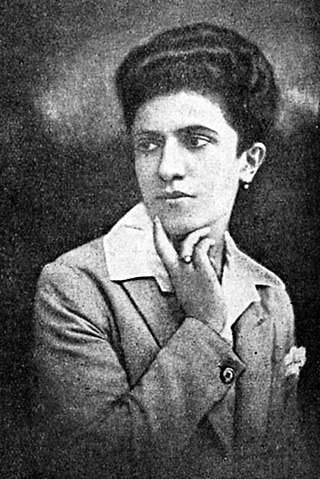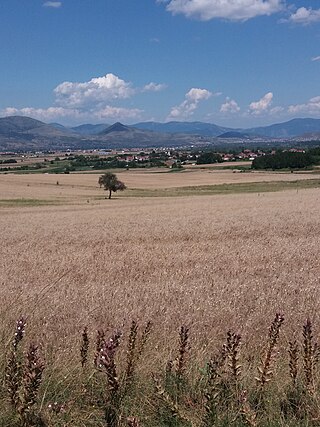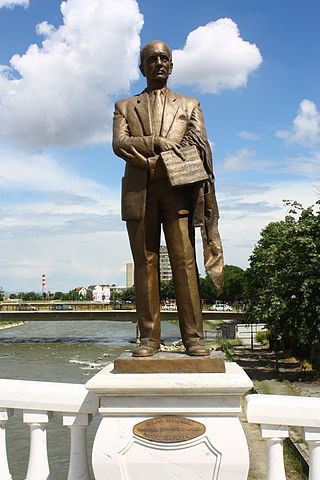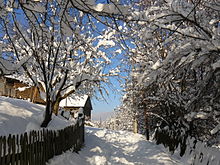
The Socialist Republic of Macedonia, or SR Macedonia, commonly referred to as Socialist Macedonia, Yugoslav Macedonia or simply Macedonia, was one of the six constituent republics of the post-World War II Socialist Federal Republic of Yugoslavia, and a nation state of the Macedonians. After the transition of the political system to parliamentary democracy in 1990, the Republic changed its official name to Republic of Macedonia in 1991, and with the beginning of the breakup of Yugoslavia, it declared itself an independent country and held a referendum on 8 September 1991 on which a sovereign and independent state of Macedonia, with a right to enter into any alliance with sovereign states of Yugoslavia was approved.

Jovan Ajduković is a Serbian linguist.

Mara Buneva was a Macedonian Bulgarian revolutionary, member of the Internal Macedonian Revolutionary Organization. She is famous for the assassination of the former Serbian Chetnik commander and Yugoslav legal official of the Skopje Oblast Velimir Prelić, after which she committed suicide. Today Buneva is considered as a heroine in Bulgaria, while in Serbia and North Macedonia she is regarded as a controversial Bulgarophile.

Kalochori (Greek: Καλοχώρι, before 1926: Δοβρόλιτσα - Dovrolitsa; Macedonian Slavic: Добролишта, Bulgarian: Добролища, Добролишча in the Kostur dialect, is a small rural village, part of the municipal unit of Kastoria, Kastoria regional unit, Greece. Kalochori is also located 14 kilometers away from the city of Kastoria and 14 kilometers away from the village of Nestorio. It was a part of the former municipal unit of Mesopotamia. The village has an elevation of 721 meters above sea level.

Resen is a municipality in southwestern Republic of North Macedonia. Resen is also the name of the town where the municipal seat is found. Resen Municipality is located in the Pelagonia Statistical Region.
Bulgarians are an ethnic minority in North Macedonia. Bulgarians are mostly found in the Strumica area, but over the years, the absolute majority of southeastern North Macedonia have declared themselves Macedonian. The town of Strumica and its surrounding area were part of the Kingdom of Bulgaria between the Balkan wars and the end of World War I, as well as during World War II. The total number of Bulgarians counted in the 2021 Census was 3,504 or roughly 0.2%. Around 98,000 nationals of North Macedonia have received Bulgarian citizenship since 2001 and some 53,000 are still waiting for such, almost all based on declared Bulgarian origin. In the period when North Macedonia was part of Yugoslavia, there was also migration of Bulgarians from the so called Western Outlands in Serbia.
Risto Kirjazovski (Macedonian: Ристо Кирјазовски was a Macedonian historian, scientist and publisher. He fought as a Partisan in the NOF, and also participated in the Greek Civil War. After 1949 he fled from Macedonia, Greece to SR Macedonia in Yugoslavia and worked on scientific research in the Archives of Macedonia and the Institute for National History in Skopje.

The Galičnik dialect or Small Reka dialect is a member of the subgroup of western and north western dialects of the western group of dialects of Macedonian. The dialect is spoken on small territory on the mountain Bistra in western part of the Republic of Macedonia. The name of the dialect is derived by the biggest village in that area- Galičnik. Also the dialect is spoken in many other small villages including the village Gari. The Galičnik dialect is closely related with the Reka dialect which is spoken north-western of Galičnik dialect. This dialect is well known in Republic of Macedonia because of the archaic words that this dialect has. The dialect can be found in many historically important literary works for the Macedonian literature. One of the most important is Ǵorǵija Puleski and his dictionary of three languages.

Kodžadžik, is a village in the municipality of Centar Župa, North Macedonia. The village is inhabited mainly by Turks.

Gollobordë refers to a geographical area of traditionally 24 villages of which 18 are situated primarily in eastern Albania, with a small portion consisting of six villages lying within North Macedonia. This region is located within the Dibër and Elbasan counties which contain both Macedonian and Albanian villages.

National Institution Cultural Center Trajko Prokopiev - Kumanovo abbreviated NICC Trajko Prokopiev is a cultural center in Kumanovo, North Macedonia. It holds the name of the local composer Trajko Prokopiev (1909-1979). Former name was Cultural Home "Josip Broz Tito" (Дом на култура ,,Јосип Броз Тито.
Tašmaruništa is a village in the municipality of Struga, North Macedonia.
Šum is a village in the municipality of Struga, North Macedonia. The settlement is a newer village in the Struga area and has a mosque.

Historiography in North Macedonia is the methodology of historical studies developed and employed by Macedonian historians. It traces its origins to 1945, when SR Macedonia became part of Yugoslavia. According to German historian Stefan Troebst, it has preserved nearly the same agenda as Marxist historiography from the times of the Socialist Federal Republic of Yugoslavia. The generation of Macedonian historians closely associated with the Yugoslav period, who were instrumental in establishing national historical narratives, still exerts an influence on modern-day institutions. In the field of historiography, communism and Macedonian nationalism are closely related. After the Fall of communism, Macedonian historiography did not significantly revise its communist past, because of the key role played by communist policies in establishing a distinct Macedonian nation.
Laimos is a village in the Florina Regional Unit in West Macedonia, Greece. It is the seat of the Prespes Municipality.
Pyli is a village in the Florina Regional Unit in West Macedonia, Greece.

This is an article about the suburb near the town of Štip. Not to be confused with the village with the eponymous name in the southern part of the Štip Municipality.
Dimitar Krstev Dičov, also known as Dičo Krstev and best known as Dičo Zograf (1819–1872) was a Mijak iconographer, fresco painter and a representative of the Debar Art School in the Balkans in the 19th century. He self-identified as a Bulgarian.

Alekso Martulkov, born as Aleksandar Ončev Martulkov, was a publicist and one of the first socialist revolutionaries from the region of Macedonia. He was a member of the Bulgarian Workers' Social Democratic Party and later the People's Federative Party and the Bulgarian Communist Party. Simultaneously, he was a member of the IMRO and subsequently the IMRO (United). He advocated for the independence of Macedonia. Martulkov was also a member of the Bulgarian Parliament, as well as the Presidium of ASNOM and the parliament of SR Macedonia. He is considered a Macedonian in the Macedonian historiography and a Bulgarian in the Bulgarian historiography.

Dimče Gjošev Mirčev was a Macedonian communist and partisan. He was awarded posthumously the Order of the People's Hero on 2 August 1949.













